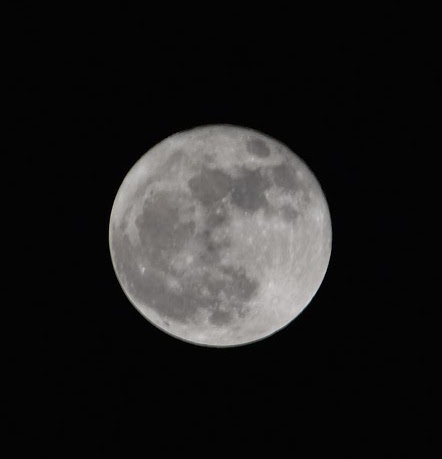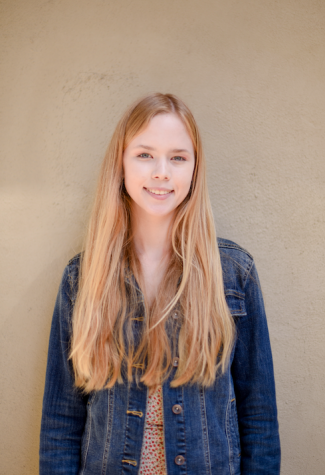Supermoon lights up sky on Sunday

The moon at 9 p.m. PST, as viewed from California. The supermoon will be most visible during the early morning hours of Dec. 4.
December 4, 2017
This year’s brightest supermoon occurred from the night of Dec. 3 to the night of Dec. 4.
On Sunday night, the moon will be almost as close as possible to the Earth. It will appear 16 percent brighter and seven percent larger. The supermoon can be seen from any place in the world with clear skies; however, the view is best from a dark place.
“I recommend going up into the hills toward the parking lot at Sky Line that the bicyclists use for staging at Highway 35 and Highway 9 because there’s parking there,” astronomy teacher Dr. Eric Nelson said. “It’s flat, and the trees have been cleared reasonably well.”
The moon orbits the Earth in an ellipse, meaning that it is not the same distance from the Earth year-round. The point at which it is closest to Earth is called perigee, and the point at which it is furthest from the Earth is the apogee. A “supermoon” is common: any moon that appears larger than usual is a supermoon as it is closer to perigee than apogee.
As perigee is also the point at which moon is closest to the Sun, the supermoon will be brighter than usual. Because of this, there is some risk of damage to the eyes.
Supermoons occur annually and they often draw spectators attempting to capture a rare astronomical phenomenon.
“Full moons are lousy for astrophotography,” Dr. Nelson said. “There are no shadows, which means you don’t have a lot of contrast.”
Timothy Chang (11) is interested in astrophotography and has taken pictures of the moon in the past.
“You just need a really long lens,” he said. “You [also] need to find the right angle and you need to plan it out. You have to do research ahead of time.”
Certain camera settings can improve the quality of the photo.
“You shutter speed should be one over your focal length. So if your lens is 300 mm, then your slowest shutter speed should be 1/300 of a second,” Timothy said. “Beyond that, I think aperture is not that important, and then [for] ISO, keep it as low as possible.”
According to NASA’s website, daylight white balance is optimal for shooting a picture of the moon. Additionally, adding a terrestrial landmark into the composition may enhance the photo, emphasizing the size of the moon.
Weather permitting, a meteor shower will be visible in the Americas before dawn on Dec. 14 this year. Additionally, a total lunar eclipse should be partially visible on Jan. 31, 2018.


















![“[Building nerf blasters] became this outlet of creativity for me that hasn't been matched by anything else. The process [of] making a build complete to your desire is such a painstakingly difficult process, but I've had to learn from [the skills needed from] soldering to proper painting. There's so many different options for everything, if you think about it, it exists. The best part is [that] if it doesn't exist, you can build it yourself," Ishaan Parate said.](https://harkeraquila.com/wp-content/uploads/2022/08/DSC_8149-900x604.jpg)




![“When I came into high school, I was ready to be a follower. But DECA was a game changer for me. It helped me overcome my fear of public speaking, and it's played such a major role in who I've become today. To be able to successfully lead a chapter of 150 students, an officer team and be one of the upperclassmen I once really admired is something I'm [really] proud of,” Anvitha Tummala ('21) said.](https://harkeraquila.com/wp-content/uploads/2021/07/Screen-Shot-2021-07-25-at-9.50.05-AM-900x594.png)







![“I think getting up in the morning and having a sense of purpose [is exciting]. I think without a certain amount of drive, life is kind of obsolete and mundane, and I think having that every single day is what makes each day unique and kind of makes life exciting,” Neymika Jain (12) said.](https://harkeraquila.com/wp-content/uploads/2017/06/Screen-Shot-2017-06-03-at-4.54.16-PM.png)








![“My slogan is ‘slow feet, don’t eat, and I’m hungry.’ You need to run fast to get where you are–you aren't going to get those championships if you aren't fast,” Angel Cervantes (12) said. “I want to do well in school on my tests and in track and win championships for my team. I live by that, [and] I can do that anywhere: in the classroom or on the field.”](https://harkeraquila.com/wp-content/uploads/2018/06/DSC5146-900x601.jpg)
![“[Volleyball has] taught me how to fall correctly, and another thing it taught is that you don’t have to be the best at something to be good at it. If you just hit the ball in a smart way, then it still scores points and you’re good at it. You could be a background player and still make a much bigger impact on the team than you would think,” Anya Gert (’20) said.](https://harkeraquila.com/wp-content/uploads/2020/06/AnnaGert_JinTuan_HoHPhotoEdited-600x900.jpeg)

![“I'm not nearly there yet, but [my confidence has] definitely been getting better since I was pretty shy and timid coming into Harker my freshman year. I know that there's a lot of people that are really confident in what they do, and I really admire them. Everyone's so driven and that has really pushed me to kind of try to find my own place in high school and be more confident,” Alyssa Huang (’20) said.](https://harkeraquila.com/wp-content/uploads/2020/06/AlyssaHuang_EmilyChen_HoHPhoto-900x749.jpeg)






